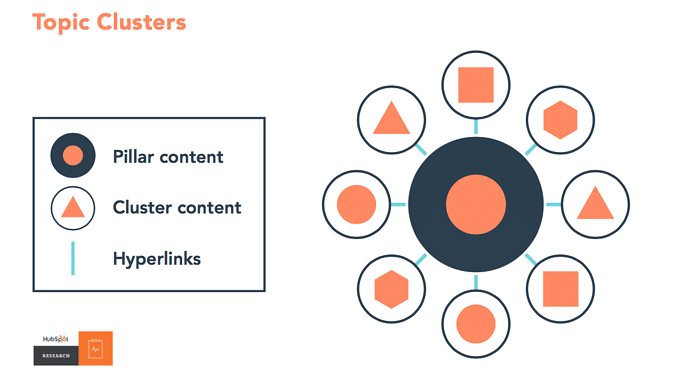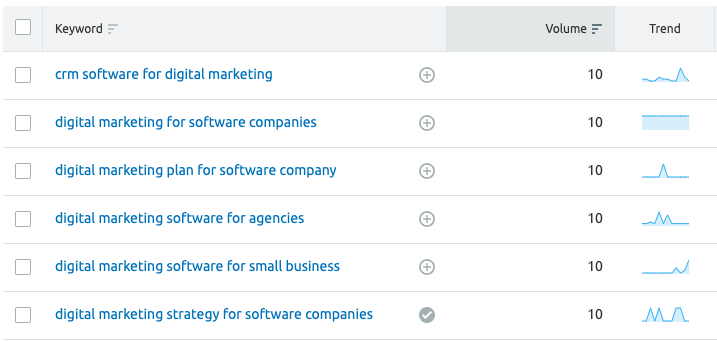7 Rules for B2B Technology Marketing

Introduction
Our 7 rules for running a successful technology marketing strategy based on our experience of working in and with growing and established B2B technology businesses.
Technology marketing is a growing specialism, new technology products are being launched everyday and they all require some form marketing whether its built it the product itself or its through a high-touch sales approach requiring lots of outbound activities.
We’ve worked with and for technology companies helping them define their digital marketing strategies and we’ve learnt a few things along the way, from this experience we’ve put together our 7 rules for success to hopefully give you a head start with your own technology product and marketing strategy.
We’ll cover the importance of data, knowing the technology category you’re in and how you should think about investing in tactics based on the average value of your typical client or customer.
There are commonly three types of B2B technology marketing strategies, they are: SaaS Marketing, Enterprise Technology Marketing and then the ones in-between – they all have slightly different tactics but our 7 rules should apply to all of them in one way or another.
The 7 Rules
- Define your category
- Data first, creativity second
- Craft unique content
- Work backwards from revenue
- Use data to aid your content strategy
- Marketing content fuels everything
- Make it easy to buy from your company
Rule 1: Define Your Category
The importance of categorisation
It can seem obvious but defining what category the technology product or software you market sits in is essential before you do anything. If your product doesn’t fall into any of the existing categories then you may be looking at defining a new category.
If you can imagine software is one broad category with everything underneath, you may have HR software as a sub-category along with Marketing Software, but within each of these categories you can also have more and more sub-categories. For example, in marketing software you could have CRM software or SEO software to name just two.
As the the world gets more saturated with technology and products more and more of these categories crop-up as companies need to find their niche. Knowing which category you sit in is key to your marketing strategy.

Why knowing your category is key
Humans like to organise things in categories, it helps us make sense of our world. This is the same for products and even though a lot of technology products are software, we still categorise things in the same way. So if the technology product your marketing is not in a defined category it can be hard for people to a) understand it and b) discover it. Think of it as you were searching for a book in the library, you would start by looking in the different section.
The alternative here is sometimes where unicorns come in, they quite frequently define new categories. In the product world you would think of an iPad and tablet computing as an example of this. Once a new category is defined other people will look for ways at creating new categories within the existing, i.e. children’s tablets, luxury tablets, drawing tablets.
Defining which category you sit in is especially important for B2B SEO strategy, as when people are searching online they will typically use these categories as a starting point for a search.
SEO and defining your product category
One of the biggest mistakes we see companies make is trying to redefine an existing category, or not understanding they actually sit in one at all.
This often comes in the form of naming a product a “platform” or “hub”. For example, if you sell HR software and you decide you want to call it a HR platform – you need to define very clearly in your marketing what a platform is – especially if you want to rank well for SEO – as people will be searching for HR software, not HR platforms.
There needs to be a larger education piece around a new category that explains the difference for you to be able to create and then start ranking for this category using SEO – sometimes this comes down to PR.
Defining a new category and marketing it
The most successful companies define and own their own categories. This is the same for products and services, HubSpot is a great example of creating a new category in Inbound Marketing, you now have Inbound Marketing Agencies cropping up all over to serve this new category.
The mistake often made in technology marketing is trying to define a category with messaging alone. Giving a technology product a new name isn’t enough.
Rule 2: Data first, creativity second.
The most overlooked and ‘unsexy’ part of any technology marketing strategy is the data sitting on your CRM system. Most companies are so focused on the qualified leads they generate that they forget to organise, segment and automate their data to ensure a scalable solution.
One common mistake we see is companies running before they can walk when it comes to personalisation. Personalising website content or email content requires data to act upon. Whether that’s the location of the website visitor or the stage in the funnel they are in, you can personalise your marketing content for each segment.
Changing website content to match location is pretty straight forward and doesn’t require for you hold any information in your CRM software, but, if you’re looking to set some personalised email drip campaigns up you are going to need to have the data in your CRM and it needs to be standardised and organised so you can act upon it with confidence.

Automate data processing using conditions
One of the best ways to start with sorting out your CRM data is by putting in some basic data automation such as assigning a persona based on job title, i.e. if the contact’s job title is ‘x’ then assign persona ‘y’. You can then serve marketing messages based on persona tagged in your CRM.
Another example is by setting lead status by the information you have gathered on web forms. So if budget someone inputs their budget as >= £10,000 then you can automatically set them as a qualified lead in your CRM, at which point they can become a priority for your sales team. This is the basic principle behind lead scoring and there are lots of conditions for this but at its basic level you should think about the key data points to collect.
Define minimum data standards and lead qualification criteria
A good practice to get into when looking at your marketing data and indeed you CRM data as a whole is to have a set of minimum data standards. This is common practice in some large organisations such as law firms and professional service companies where client data is very important.
Minimum data standards include things such as you must have an email address, first name and last name as a minimum, and if you don’t have these 3 things then the contact is deleted after 7 days or in some cases archived, another popular method is to do this based on activity (i.e. when did you last have contact).
Usually if a contact is in this category or bucket you would have somebody manually go through the data and make any require edits or give it a final check before deletion.
Lead qualification data requirements
Defining the data you require to able to qualify a lead is very important when it comes to being able to design things such as lead capture forms on your website.
If a qualified lead for your company is a business with a team larger than 10 then that’s a data point you should look to be capturing on what we would call a ‘sales ready form’ – these are forms that when filled in they auto-qualify the lead and it goes directly to your sales teams queue or inbox to handle.
Typically a website should have at least 3 types of forms, a basic subscription form for emails, a content download form and a contact form. You can then build another level on top of this to capture more data which can be your ‘sales-ready’ form.
Rule 3: Craft unique content
Let’s say for arguments sake that you sell the same software product to a law firm and a manufacturing company, in this example it’s likely to be a higher-level category such as HR software or a CRM system like Salesforce.
In this scenario (depending on your company size) you may address the same two verticals with a similar message as both companies have a common problem.
What tends to happen is that as new competitors form, they find their ‘niche’ in this market and will focus on a certain sector in particular, making it more difficult for the more generalist company to compete with this very targeted messaging.
This of course is linked directly with your companies value proposition and the bottom line is a that a product that isn’t designed for a specific industry may struggle to compete with one that is anyway, but, if you wish to compete across multiple verticals and segments you need to personalise your content to match.
Technical vs non-technical buyers
One key task for technology marketers is producing content both technical and non-technical buyers and serving it at the right time and through the right mediums.
This means having API documentation available for developers and also having top level messaging for the CEO who may be looking at ROI implications for the business.
You should try and create a strategic messaging map for each of your key buyers both technical and non-technical so you can identify the messages for each persona. This means having a value statement, features and proof points for all your personas.

Automate personalisation
This is on the wish list of nearly every marketer looking to launch a new website, personalised content based on certain conditions.
Personalisation for large e-commerce company is key and it can be tricky and involve some smart technology. For a B2B company it doesn’t need to be anywhere near as complex.
The challenge with implementing personalisation for a B2B website can be whether to remove content from the website to build into a personalisation workflow or ensure that each personalised content is
Try Google Optimise before investing heavily
Google Optimise is a free tool in the Google Suite that allows you to change content at the time it’s served. We’d recommend trying it out for anyway thinking about implementing any sort of personalisation on their website before investing in anything too heavily.
Rule 4: Work backwards from revenue
Underinvestment is a common mistake when it comes to marketing budgets for technology companies. Especially when you consider the lifetime value or average order value of a client.
You should be choosing your technology marketing strategy based on the average order value of your users or clients. You should also be assigning budgets based on this.
We’ll talk though some of the most common marketing tactics used for B2B tech companies and how they can provide great return on investment.
PPC for quick lead generation
One of best ways to generate leads over a short period of time and have a great way to record investment vs results is by using paid advertising or paid social advertising such as running text ads through Google Ads.
The benefits of running a campaign on the Google Ads platform is that you can clearly track the performance of your ads and see how that tracks through to new deals won.
Performance marketing is very popular in e-commerce for this reason, but it’s also very effective in a B2B marketing strategy when used effectively alongside keyword research.
Lets say a new client us worth on average £50k to your business, if your willing to spend £5k through Google Ads to acquire that new client.
You know the average cost per click (CPC) for your target keywords is £5 and you can expect a conversion rate of 2%.
You can then estimate that by spending £5k through PPC you may get 1,000 clicks and 20 leads from this (2%), from those 20 you may get 10 qualified and if even one of those leads turns into a new client you have more than achieved a great ROI.
This is how performance marketing works and why it’s popular – the difficulty comes in choosing the keywords to bid on and doing it with the right landing page and content.

The value of SEO and potential ROI
For the cost of £5,000 per month you can pay a successful SEO agency to manage your SEO strategy for you, it’s something a lot businesses neglect as they can’t see the value in it, or perhaps they know it’s important but find it difficult to attribute new clients to work done on SEO.
SEO, however, can have one of the best ROIs out of any marketing activity you’ll ever do – especially if you average deal value is large. Winning one new client who found you through Google can cover the costs of an SEO agency for years.
For example, if you pay £5,000 a month for 2 years and win one deal worth £1million over the course of their agreement with your business, you’ve spent around £100k on SEO and returned £1million in revenue for the business so you’ve seen a 10x return.
This is an extreme example but it gives you an idea of the value of SEO for a technology company, especially enterprise technology. Always think about how much you are willing to spend to acquire a client. Yes, you are front-loading the cost but that’s how it works and there is nothing you can do about that.
Rule 5: Use data to aid your content strategy
Search data taken from search engines such as Google and Bing can be a great source of information for technology content marketing strategies. Rather than writing content based on what you think your audience want to read (or what you want to write about), you can answer the questions they are actually asking online.
This approach not only helps your potential buyers find the answers they are looking for online, it positions your company as a useful educational resource and it also helps increase your visibility online because you will start to rank for those search queries.
One other benefit of this approach is that you start to have conversations with potential buyers much earlier on in the B2B buyer journey, when they are at a ‘problem identification’ stage rather than waiting until they start searching for solutions.
Helping someone at this early stage in the buying process can build a much stronger relationship and level of trust as you are helping them without any commitment to purchase.
Tip: A really quick way to find ideas for content is by using the autosuggest feature built into the Google search engine. Start typing a query relating to your product or services and Google will provide you with a list of the most popular queries – try it in Incognito mode so you don’t get personalised results.

What is search or keyword data?
Search data usually comes in the form of keywords and monthly search volumes (MSV), the process of investigating this data is often called keyword research and there is a specific method to it.
This keyword data gives you an estimate of how many times in a certain geographic location a search is conducted, it’s not an exact science and it requires a bit of thinking to connect the search with what is called intent – as this is not obvious from a lot of search data.
For example by searching for “email marketing” you could looking to see what it is in general or how to do it or possibly looking for a tool to do it, it’s not clear. Below is an example of some keyword data from SEMrush – an enterprise SEO tool.
Building a content strategy using keyword data
Building a content marketing strategy for a technology company using SEO data usually takes the form of what we call a ‘content cluster’ a term coined by HubSpot when they talk about their approach to inbound marketing.
A content cluster revolves around creatine on longer piece of pillar content on a general topic and then creating smaller pieces of cluster content around that topic and creating links between them all, as indicated in the graphic below.

Relying to heavily on search data
Although the search data is really useful can provide some great insights into how to conduct a content marketing strategy to aid SEO it’s not wise to rely completely on data.
A simpler way of approaching this if you don’t have access to search data is simply to choose some “core topics” – these are topics that closely align with you value prop, for us, for example, that could be “technology marketing” or “b2b marketing”.
Within these core topics, you have sub-topics such as “b2b digital marketing” and “SaaS marketing” – you can then build a content plan around these pillars and clusters.
A quick tool to help with this you can use developed by an SEO agency is called Answer the Public, you can put some terms in there and it will give you an idea of all the questions people are asking around those subjects.
Rule 6: Content fuels technology marketing
Technology marketing is fueled by content. No matter what marketing channel you want to use, it requires content to be able to execute successfully.
Just like a website doesn’t exist without the words and pictures on the page, a Google Ad campaign won’t be successful without a well constructed landing page and lead nurturing can’t happen alongside marketing automation without the content to use in email drip campaigns and automation workflows.
B2B SEO is only successful when you have a solid content marketing strategy behind it, using the tactic mentioned earlier about using cluster content and pillar pages you can get your pages rank higher – this is what we call a content-led SEO strategy and it’s what we use for all of our B2B technology clients.

Content for Remarketing ads
Another use of content such as guides and reports is using them in a remarketing campaign targeting past website visitors who didn’t convert the first-time around.
Content can be much more persuasive and interesting than just a simple advert with your company logo and top-level messaging. As downloading content doesn’t require the same commitment as getting in touch, they are not ready to do that yet – they are too early on in their buying process.
Content for SEO
Content is the foundation of any successful B2B technology marketing strategy and SEO is a large part of this. Content for SEO is a more pragmatic approach to copywriting than what you may call thought leadership content.
Content for SEO is targeted at specific terms or topics and is planned using search data and in-depth topic research whereas thought leadership content is typically off the cuff or related to what might be in the news.
Content for lead nurturing
If you have a large database of existing leads that are just sitting there going cold then you may be thinking about using marketing automation such as an email drip campaign to nurture and move those leads down the marketing funnel.
An email drip campaign, however, requires content to use in those emails otherwise you have nothing to offer leads at an early stage of buying process, the CTA has to be around content, not get in touch or book a demo, that comes later in the funnel.
Content for Paid Social
A common mistake many people make, especially with LinkedIn ads is promoting content such as blog posts rather than more useful and educational lead generating pieces such as an ebook or white-paper.
Paid social campaigns require content to be able to generate top of funnel leads, even if it’s just to build awareness around your product or service – content again is the fuel behind the strategy.
Rule 7: Make it easy to buy from you
This is a bit of a general one to be honest but it should be at the heart of every technology marketing strategy.
Too often we think of all the reasons why people don’t convert and what other tactics we can be trying to generate more qualified leads. But, really you should be thinking about how can you make it easy for your potential buyers to buy from you.
An easy to use website
This is common knowledge but it’s worth mentioning again. If a website is difficult to navigate, slow to load or its content is confusing it’s going to make it difficult for anyone to get in touch, even if they think you are the right company.
An easy to use website directs the user straight towards the information they require to make an informed decision. You need to think about all the questions a buyer may have about your business and how you can answer them

Educate to enable sales
With technology products and services there can often be quite an in-depth educational journey that needs to take place before a buyer can realise your solution is the answer to their problem.
This can be as simple as explaining how different systems integrate into one another and explaining the whole eco-system rather than just how your particular product integrates.
This is another area where content comes into play, by producing content explaining the basics and giving useful advice you’re educating your buyers and by educating them they can then make a more informed decision.
It can be frustrating for a sales team to have to first explain the importance of their solution as they are trying to sell it, by producing more educational content through your marketing strategy you can answer these questions earlier on so your sales team only need to concentrate on selling the product not the solution.
Answer your buyer questions
Can I trust this company? Who have they worked with before? Do they sell the solution I’m looking for? How much does it cost? How long will it take to implement? Will it integrate with my current software? These are all typical questions that a technology buyer may be asking when considering a company.
You need ensure the content on your website addresses all of these questions and the answers are easy to find on your website.
Build trust quickly
One of the biggest barriers for B2B buyers is trust, can they trust your company? Can they trust what you’re saying and that you will deliver on your promises?
One of the easiest and quickest ways of building trust with potential buyers with elements such as logos of companies you have previously worked with and testimonials from past clients.
It’s not enough to have these elements hidden away on your website, they need to be front and centre at the top of the page ideally.
Get In Touch
Get in touch to find out how we can help you with your technology marketing strategy.

